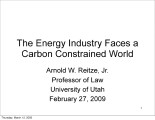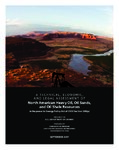TO
1 - 25 of 20
| Title | Date | Subject | Description | ||
|---|---|---|---|---|---|
| 1 |
 |
Areawide and local effects of tar sands development at the Sunnyside site in Utah: A socioeconomic analysis | 1984-04 | The Combined Hydrocarbon Leasing Act of 1982 (Public Law 97-78) provides guidelines for converting federal oil and gas leases to combined hydrocarbon leases in Special Tar Sands Areas (STSAs). The STSAs are designated by the U.S. Department of the Interior as areas that contain substantial deposits ... | |
| 2 |
 |
The energy industry faces a carbon-constrained world | 2009-02-27 | carbon regulation; energy industry; carbon control; CO2 sequestration; GHG. | Analysis of the impacts of potential frameworks for carbon regulation on the energy industry, presented at the 2009 Western U.S. Oil Sands Conference by Arnold W. Reitze, Jr., Professor, S.J. Quinney College of Law, University of Utah. |
| 3 |
 |
Climate change regulation via the back door | 2011-05-17 | ||
| 4 |
 |
Balancing energy resources | 2008-05-23 | Utah; Rocky Mountain Power; Wyoming; Utah Energy; Energy deficit; Greenhouse gas; Energy resources; Coal | Fulfilling our obligation: 1-Investing in the system to satisfy growing demand 2-Meeting increasing customer expectations with respect to the quality of our service 3-Addressing increasing concerns regarding the environment |
| 5 |
 |
Draft environmental impact statement on conversion of oil and gas leases to combined hydrocarbon leases, Tar Sand Triangle, Utah | 1984-07-16 | The Draft Environmental Impact Statement will provide the Regional Director, National Park Service, and State Director, Bureau of Land Management, with the necessary information to make a decision on whether existing oil and gas leases in Glen Canyon National Recreation Area and on adjacent BLM land... | |
| 6 |
 |
Policy analysis of water availability and use issues for domestic oil shale and oil sands development: Topical Report: October 1, 2009 to March 31, 2010 | 2010-03 | oil shale/sands resources; energy source; unconventional fuels; water demands; water availability; domestic oil shale/sands development; topical report | Oil shale and oil sands resources located within the intermountain west represent a vast, and as of yet, commercially untapped source of energy. Development will require water, and demand for scarce water resources stands at the front of a long list of barriers to commercialization. Water requiremen... |
| 7 |
 |
APPENDIX A - Analysis of environmental, legal, socioeconomic and policy issues critical to the development of commercial oil shale leasing on the public lands in Colorado, Utah and Wyoming under the mandates of the Energy Policy Act of 2005 - Final Project Report - Reporting period: June 21, 2006 to October 21, 2009 | 2009-10 | Oil shale; Colorado; Utah; Wyoming; Energy Policy Act of 2005; Green River Formation; Environmental; Legal; Socioeconomic; Policy Issues; Oil shale deposits; BLM; Bureau of Land Management | The United States is home to the largest oil shale deposits in the world. This resource is located in the Green River Formation, spreading across the states of Colorado, Utah and Wyoming. Despite the vast potential of this resource, successful commercial development has yet to occur. To date, concer... |
| 8 |
 |
A technical, economic, and legal assessment of North American heavy oil, oil sands, and oil shale resources: In response to Energy Policy Act of 2005 Section 369(p) | 2007-09 | Oil sands; Oil shale; Heavy oil; Energy Policy Act; 2005; Climate Change; Petroleum; Oil Cost; United States; North American heavy oil; Utah Heavy Oil Program; UHOP; World economic development; Energy; Canadian oil sands; Unconventional resources ;Technical; Economic; Legal assessment | Against the backdrop of world population growth, rapid economic expansion in the world's most populous countries, challenging political climates in many oil-producing nations, and the specter of climate change, worldwide energy consumption is projected to increase from the 2004 level of just over 40... |
| 9 |
 |
Strategic significance of America's oil shale resource: Volume 2--oil shale resources technology and economics | 2004-03 | oil shale resource; oil shale; alternative fuel source; oil shale technology. | It is generally agreed that worldwide petroleum supply will eventually reach its productive limit, peak, and begin a long-term decline. What should the United States do to prepare for this event? An objective look at the alternatives points to the Nation s untapped oil shale as a strategically locat... |
| 10 |
 |
Biofuels--snake oil for the twenty-first century | 2008-12-01 | Most Americans are painfully aware that our present consumption of petroleum is unsustainable. The United States has less than 5% of the world's population, but consumes 24.4% of the world's petroleum production. Only 8.5% of the world's petroleum production comes from American wells, which necessit... | |
| 11 |
 |
Understanding the outcomes of megaprojects: A quantitative analysis of very large civilian projects | 1988-03 | Megaprojects; mineral resources; RAND. | Megaprojects--projects requiring huge physical and financial resources--have become relatively common in the past 15 years, as a result of demands for new remote mineral resources, needs for infrastructure in less-developed countries (LDCs), and the desire to exploit economies of scale. Despite the ... |
| 12 |
 |
Oil shale in the West: 14 unanswered questions | 2009-06 | oil shale; Western oil shale; oil shale development | This report summarizes recent research and policy documents to provide a brief overview of the current state of oil shale development in the U.S. West. Recent high crude oil prices, anticipation of a peak oil crisis, and a focus on developing domestic sources of fossil fuel have contributed to a ren... |
| 13 |
 |
Chemical looping combustion reactions and systems: Task 5 topical report | 2011-08 | Chemical looping combustion; CLC; Fuel combustion; CO2 capture; Electric power; Sequestration; FBR; CLOU; Thermogravimetric analysis; CO2; Carbon dioxide | Chemical Looping Combustion (CLC) is one promising fuel-combustion technology, which can facilitate economic CO2 capture in coal-fired power plants. It employs the oxidation/reduction characteristics of a metal, or oxygen carrier, and its oxide, the oxidizing gas (typically air) and the fuel source ... |
| 14 |
 |
Strategic significance of America's oil shale resource: Volume 1--assessment of strategic issues | 2004-03 | oil shale; oil shale resource; petrolium production; tar sand; oil shale development. | It is generally agreed that worldwide petroleum supply will eventually reach its productive limit, peak, and begin a long-term decline. What should the United States do to prepare for this event? An objective look at the alternatives points to the Nation's untapped oil shale as a strategically locat... |
| 15 |
 |
Carbon capture and sequestration: A regulatory gap assessment - Topical report | 2012-04 | carbon capture and sequestration; gap assessment; CCS; climate change | Though a potentially significant climate change mitigation strategy, carbon capture and sequestration (CCS) remains mired in demonstration and development rather than proceeding to full-scale commercialization. Prior studies have suggested numerous reasons for this stagnation. This Report seeks to e... |
| 16 |
 |
Policy analysis of the Canadian oil sands experience-Topical Report | 2013-09 | Topical Report; Oil & Natural Gas Technology; October 1, 2009-September 30, 2014; Canadian Oil Sands; Policy; Subtask 6.2 | For those who support U.S. oil sands development, the Canadian oil sands industry is often identified as a model the U.S. might emulate, yielding financial and energy security benefits. For opponents of domestic oil sands development, the Canadian oil sands experience illustrates the risks that oppo... |
| 17 |
 |
APPENDIX E - Integrated treatment of produced water by chemical and biological unit operations, A subpart of project - Quantifying water availability impacts and protecting water quality while developing Utah oil shale and sands - Final Project Report - Reporting period: June 21st, 2006 to October 21st, 2009 | 2010-10-07 | Water treatment; Water quality - Utah; Oil shale and sands | Water generated along with oil, gas, and coal bed methane production is commonly known as produced water, formation water, or oilfield brine [1]. Produced water represents the largest waste stream volume in production operations on most offshore platforms [2]. According to the American Petroleum Ins... |
| 18 |
 |
Assessment of research needs for oil recovery from heavy-oil sources and tar sands | 1982-03 | The Fossil Energy Research Working Group (FERWG), at the request of J. W. Mares (Assistant Secretary for Fossil Energy) and A. W. Trivelpiece (Director, Office of Energy Research), has reviewed and evaluated the U.S. programs on oil recovery from heavy oil sources and tar sands. These studies were p... | |
| 19 |
 |
Uinta Basin tar sand deposits | 1990 | Uinta Basin; Tar sand deposits; Utah | This report addresses an important need to the State of Utah; to define, tabulate, and document an economic resource which has aroused the interest of industry and academia and which is vastly undeveloped and little understood as to its potential. The need for this report has grown since the last ta... |
| 20 |
 |
Economic impacts of U.S. liquid fuel mitigation options | 2006-07-08 | Oil; Oil shortages; United States dependence on oil imports; Energy Security; Vehicle fuel efficiency (VFE); Coal liquefaction; Coal-to-liquids (CTL); Oil shale; Enhanced oil recovery (EOR); Oil peaking; Liquid fuels | The world is consuming more oil than it is finding, and at some point within the next decade or two, world production of conventional oil will likely peak. Peaking will lead to shortages and greatly increased prices and price volatility. In addition to peaking and its consequences, there are widespr... |
1 - 25 of 20
